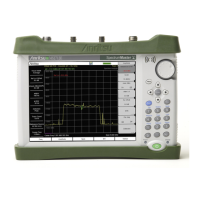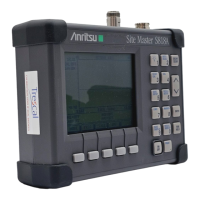Chapter 3 — Options Verification 3-10 Option 884, EVDO Signal Analyzer Option Verification
MS2720T MM PN: 10580-00342 Rev. D 3-39
QPSK Modulation Channel Power, Frequency Error, Rho, and Tau Tests
Test Procedure
1. Ensure that the equipment settings are unchanged from the previous test.
2. On the MG3700A, change the selected pattern to FWD_38_4KBPS_16SLOT.
3. On the power meter, press the Sensor key, the Cal Factor submenu key, and then the Freq submenu key.
Use the keypad to enter 1930 MHz as the input signal frequency, which sets the power meter to the
proper power sensor calibration factor. Press the System key to display the power reading.
4. Set the MG3700A Frequency to 1930.05 MHz.
5. Adjust the MG3700A output so that the power meter reads 0dBm±0.2dB, and record the actual value as
shown on the power meter into Table A-104, “RF Measurements, At 1930.05 MHz, 0 dBm Level, 38.4 kps
QPSK Modulation” on page A-51.
6. On the MS2720T, press the Freq main menu key and enter 1930.05 MHz as Center Freq. Then wait
15 seconds to allow the MS2720T to update its measured results.
7. Record the “MS2720T Reading”, the displayed Channel Power value, into Table A-104.
8. Subtract the “MS2720T Reading” of displayed Channel Power value from the “Power Meter Reading” in
Step 5. Then record the “Calculated Channel Power Error” into Table A-104.
9. Record the displayed Freq Error, Rho Pilot and Tau into Table A-109, “Demodulation, At 1930.05 MHz,
0 dBm Level, 38.4 kps QPSK Modulation” on page A-52.
10. Verify that the measured values in Step 8 and Step 9 are within specifications.
16QAM Modulation Channel Power, Frequency Error, Rho, and Tau Tests
Test Procedure
1. Ensure that the equipment settings are unchanged from the previous test. The power sensor Cal Factor
frequency should still be at 1930 MHz, and the MG3700A frequency and MS2720T Center Frequency
should still be at 1930.05 MHz.
2. On the MG3700A, change the selected pattern to FWD_2457_6KBPS_1SLOT.
3. Adjust the MG3700A output so that the power meter reads –50 dBm ± 0.2 dB, and record the actual value
as shown on the power meter into Table A-105, “RF Measurements, At 1930.05 MHz, –50 dBm Level,
2457.6 kps 16QAM Modulation” on page A-51.
4. Then wait 15 seconds to allow the MS2720T to update its measured results.
5. Record the “MS2720T Reading”, the displayed Channel Power value, into Table A-105.
6. Subtract the “MS2720T Reading” of displayed Channel Power value from the “Power Meter Reading” in
Step 3. Then record the “Calculated Channel Power Error” into Table A-105.
7. Record the displayed Freq Error, Rho Pilot and Tau into Table A-110, “Demodulation, At 1930.05 MHz,
–50 dBm Level, 2457.6 kps 16QAM Modulation” on page A-53.
8. Verify that the measured values in Step 6 and Step 7 are within specifications.
Idle Slot Channel Power, Frequency Error, Rho, and Tau Tests
Test Procedure
1. Ensure that the equipment settings are unchanged from the previous test. The power sensor Cal Factor
frequency should still be at 1930 MHz, and the MG3700A frequency and MS2720T Center Frequency
should still be at 1930.05 MHz.
2. On the MG3700A, change the selected pattern to FWD_IDLE.

